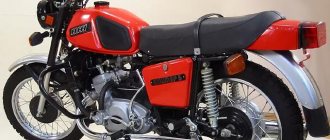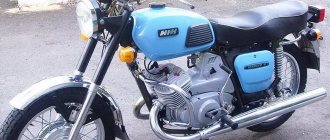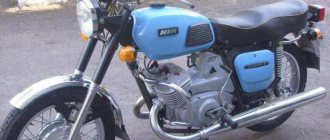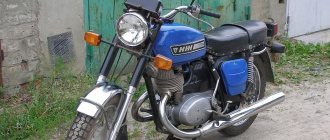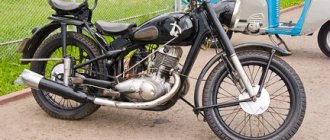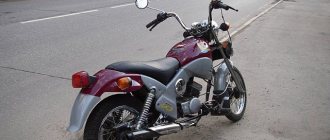Soviet motorcycles today are considered valuable transport, because back then they produced really high-quality and fast equipment. The Izh Jupiter 5 motorcycle is considered one of these legends of the USSR.
The Izhevsk plant produced several models, including Planet 5 and others. But Jupiter 5 was remembered primarily for its unpretentiousness on roads and maneuverability. With its small dimensions, the model was able to achieve low fuel consumption.
pros
- powerful engine;
- sharp at start;
- spare parts for Izh Jupiter 5 are inexpensive and available;
- soft suspension;
- low cost;
- has 2 cylinders.
Minuses
- weak front fork;
- requires good ignition settings;
- high fuel consumption;
- Motorcycles today require frequent repairs.
Review
Classic transport has always been valued since the USSR, and 20 years ago Jupiter 5 was one of the best. Today, most riders ride foreign fast motorcycles, but occasionally you can meet a former legend of the 80s and 90s. In those years, only his brother Planet 5 competed with Jupiter, but he could not compare with the motorcycle in terms of characteristics. Their main difference was the difference in cylinders, and therefore power.
If we continue to compare these two competitors, we can highlight the fact that both models had almost the same data. For example, they had one tubular frame, and a special subframe was installed to better secure the rear wheel. In general, the entire design of Jupiter 5 was quite standard and simple, the engine was attached to the frame, the fuel tank was located above, and the headlight and dashboard were installed on the steering wheel.
In the photo of Izh Jupiter 5 you can see that below the seat there are two compartments with protection. These were glove compartments, each of which was intended for a specific purpose: the right one was for tools, and the left one housed the battery. There were also 2 exhaust pipes installed that ran through the entire motorcycle. Sometimes the pipes got hot and could cause a burn, but the manufacturer installed them below the footpegs to keep the passenger as safe as possible.
Even the first models of the Izh Jupiter 5 motorcycle had simple drum brakes with a mechanical drive, but subsequent modifications received a front disc brake with a hydraulic drive.
Motorcycle appearance
When the Jupiter 5 model came out, its design was already well-known, because it was inherited from the Jupiter 4 motorcycle. But soon the Izh Planet 5 appeared on sale, and the developers saw that they could borrow several design elements.
The first modification had a square-shaped dashboard, which consisted of several indicators, an ignition switch and a speedometer. But soon its appearance was redesigned, and instead of one dashboard there were two. On the first part they placed warning lamps, and on the second part they decided to put a speedometer.
The design of the fuel tank has also been slightly redesigned, with rubber pads on the knees and the shape of the tank itself has become slightly different. Accordingly, in the new modifications of the Moto Izh Jupiter 5, it received a different, longer seat that ended at the brake light. This innovation is still considered stylish and modern.
During the Soviet era, creating high-quality and impressive equipment was as easy as shelling pears, because the country had all the resources for this. Thus, the Izhevsk plant produced a motorcycle that is capable of carrying a load of up to 500 kg. Just imagine what could be carried on this transport!
Being a workhorse, the motorcycle had a fairly sporty appearance and excellent top speed. With a power of 25 hp. the motorcycle could accelerate to 120 km/h. This is a completely standard indicator, because another representative of the Dnepr could give a maximum speed of 110 km/h. In severe frosts down to 30 degrees, the unit started up perfectly, which cannot be said about the current new products. Unfortunately, many owners complain of frequent engine breakdowns due to their long lifespan.
Why IZH Planeta 3 was one of the best Soviet motorcycles
There have already been many posts here about motorcycles from the times of the Soviet Union and their prices. They also wrote about motor vehicles, which were very common and in demand in the villages of the USSR. Today, friends, we will remember one of the best Soviet motorcycles.
Motorcycle "IZH Planet - 3"
Motorcycle "IZH Planet - 3"
"IZH Planet - 3"
This name alone is enough to make motorcycle lovers feel a little nostalgic. At the same time, it does not matter at all whether a person experienced the Soviet era or not. Many people remember, if not their motorcycle, then the motorcycle of their father or older brother. This magazine clipping from 1975 will help us find out how much such a motorcycle cost.
Motorcycle prices for 1975.
Prices are indicated on the penultimate line. Prices may vary from year to year. The Izh Planeta-3 motorcycle cost 670 rubles. Is it expensive or not? If you stay at home and don’t work, it’s expensive. And if a village boy gets a job as a combine operator’s assistant for a season, then the price is quite reasonable. And you don’t need to save money for many years, as was the case with buying a car at that time. No need to stand in line for years. I went to a regional city or district center and bought it. Well, not this time, but next time you’ll definitely buy it :)
Soviet store with motorcycle equipment
The price of the IZH Planeta 3 motorcycle is comparable to the price of a color TV of that time. In the late seventies, different brands of Soviet color televisions cost almost the same.
Motor vehicles were very common in both villages and cities. I, a city schoolboy, already had a Riga-11 moped at 14.
Here are a few reader comments as an example:
- My classmate grew up without a father; there were 3 brothers in the family. The eldest one had “ChZet”, the middle one “Minsk”, the classmate had “Voskhod”.
- Yes. In rural areas, almost every yard had a motorcycle. If not “Ural”, then “Voskhod”. And if the village is on the banks of a large river or lake, then a boat motor. By the way, in the villages almost no one had a boatmaster’s license, but they went on motorboats.
The Soviet motorcycle industry was and is rightfully considered one of the best in the world. Alas, Soviet, but not Russian. Our Soviet factories produced motorcycles of such high quality that some of them still serve their owners well. Motorcycles produced in the Soviet Union were distinguished by their durability and high speed for that time.
What was the IZH Planet 3 motorcycle like, and why is it one of the best motorcycles in the Soviet Union?
- The engine is single-cylinder, two-stroke (which means you need to refuel not with pure gasoline, but with a mixture of oil)
- Air cooling
- Tank with a capacity of 18 liters
- Maximum speed 110 km/h
- Fuel consumption on the highway is no more than 5 liters per 100 km
- Four-speed gearbox
- The frame of the motorcycle was tubular and welded. Simple and reliable.
- Cylinder volume 346 cm3
Our country produced motorcycles of various brands.
Among them were: “Minsk”, “Voskhod”, “Izh”, “Ural”, “Dnepr”, “Kovrovets” and many others. All of the above motorcycles were quite popular, however, there were iron horses that stood out from the rest. Those that showed all the non-standard thinking of workers at motorcycle factories, their taste, and most importantly, their ability to follow modern trends of that era.
This was the IZH Planeta 3 motorcycle. And if a guy of that time had this iron horse, then his coolness among his friends would skyrocket.
Inexpensive, but reliable and unpretentious, this motorcycle not only was a powerful competitor to its overseas counterparts, but in some respects it outperformed them.
"IZH Planet - 3". There is probably no one on the territory of the former Soviet republics who has not at least heard about such a miracle, while some lucky ones still ride it to this day.
“IZH Planeta - 3” fit perfectly into two categories at once: a sports motorcycle and at the same time a biker motorcycle.
This was also facilitated by the fact that this motorcycle included a removable sidecar, and this, in turn, not only significantly facilitated control, but also added to the aesthetics of this iron horse.
In a word, “IZH Planet - 3” is a golden page in the era of the Soviet motorcycle industry and the quality of this motorcycle can be envied by some modern motorcycles. Did you have a motorcycle?
Price
Today, a motorcycle of this model is not so difficult to find; in Soviet times it was bought in large quantities, so today you just need to find out how much the Izh Jupiter 5 costs. Of course, the price depends on the condition, because over such a long period many parts could become faulty.
Even during the release of the Izh Jupiter 5 , its price was quite high - 1,050 rubles. But this did not stop buyers; they wanted a comfortable and fast motorcycle, which was the best then. But still, compared to other motorcycles, this model had a relatively low price. For example, then new Ural motorcycles had a price of 1,870 rubles.
If you want to buy a legend of the USSR today, be prepared to pay 55,000 rubles for a new motorcycle. Yes, they are still being reliably produced. If this price is too high for you, buy a used model - its price ranges from 5 to 40 thousand rubles.
If you want to learn more about IZ motorcycles, and this model in particular, download the instruction manual - IZ Manual.
If you want an adult explanation, please do. Remember the basis of economic theory (and beyond ideology, etc.)? Resources are always limited. And resp. they have some finite value. They can even be renewable and have the ability to multiply their number. But they are still limited at a particular point in time. A resource can be either a physical object or an intellectual object or the work that generated it. Everything that humanity considers valuable and important for achieving certain goals is a resource. At some point, everyone agreed that it was most convenient to value this abstract resource in equally abstract money. Although at first they were tied to real things like gold, the development of scientific thought, mathematical analysis and understanding of existence gave people the idea that this was meaningless. Because money still remained a more abstract concept. In general, when creating (and destroying) something, you always use resources. And their limitations force you to take them away in one place and add them in another. In order to prevent the system from collapsing due to distortions during these movements, it was decided to pay for resources. Those. despite the fact that in one place there is a conditional loss of resources, in this place there remains a guarantee that they can replenish the spent resources or receive other resources needed by this place for the same deposit (i.e. in the amount of this deposit). If this is not do (and simply take away the resource), then an imbalance is created. And the destruction of resources with their subsequent redistribution. Each such effect in society is reflected by successive waves of “concentration of power among the rich, increasing poverty” and other socio-economic crises.
The planned system built in the Soviet Union was created as a system that would prevent this from happening, thanks to manual control at every level. But it turned out that the world market for goods and services that developed at that time (the so-called free market) turned out to be a more effective way. Not ideal. With many problems. But just more efficient. Simply because in manual mode it is impossible to keep track of everything. Moreover, this cannot be done by trying to cross a hedgehog with a snake, on the one hand, leaving money and the ability to buy (that is, still leaving the possibility of assessing at least the labor force in monetary terms), but denying the market as such in other planning tools. That's the whole sad story.
So far, the free market is simply the best tool, due to the fact that many things are left to self-determination. There are only general rules that guarantee the parties reimbursement of expended resources in the form of money, and issues of local redistribution are decided by market participants themselves, at almost all levels. And not according to the plan from above.
Honestly. While I was writing I thought I was going crazy. But I can’t imagine how to explain some of the basic principles of economics even more simply without going crazy.

